75th anniversary of D-Day...
- Thread starter crimsonaudio
- Start date
- Status
- Not open for further replies.
I think the reasons the Allies went with Italy before Marseilles were two:How about starting with Marseilles, rather than Italy?
1. It was the obvious choice in the summer of 1943, since they had captured all of North Africa and Sicily was within range for land-based aircraft, making an amphibious invasion possible.
2. Going after Italy could get the Italian government to collapse, getting the Italians out of the war.
Once the Italian government had collapsed, there was little point in continuing to attack in terrain so advantageous for the defenders.
I think it was the limited LSTs, actually. IIRC there was a critical shortage of them throughout the war and they were used heavily in the Pacific theater's island-hopping.If it was just amphibious resources, I'd have to see which resources and what they were doing. Maybe it was limited LSTs. An apocryphal quote from Churchill went something like, "Six months ago, I did not know what an LST was. Now the fate of empires depends on the d___ things." The Allies were managing LSTs by the "eaches" (i.e. managing what each and every one was doing because they were too scarce a resource to be wasted).
August 16, 1944: The Americans continue their progression to the east of Argentan and Alencon, and the pursuit of the German forces fleeing to Falaise. Dreux and Chartres are liberated by the XX Corps and the XV Corps (both 3rd Army). The Canadians and the Poles (to the north of Argentan) continue their progress as well: Falaise is finally liberated by the 2nd Corps belonging to the Canadian 1st Army (led by General Crerar). By nightfall the 21st Army Group (led by General Montgomery) controls the following towns (from west to east): Condé-sur-Noireau, part of the town of Flers, Saint-Denis and Pont-d'Ouilly. Difficult fighting continues near the village of Trun, which is ultimately liberated by the Canadians. At 03:30 pm General Montgomery orders the closure of the pocket from the village of Trun, though Bradley believes it is already too late and that much of the German army has retreated towards the Seine river.
The Allies begin preparing a new offensive, codenamed Operation Paddle, in order to break the German lines to the east of Caen. The launch of this offensive is planned for August 17 and is to be led by the Belgian brigade of Colonel Piron. The first soldier of the Belgian Piron Brigade is killed in Normandy on August 16 - private Edouard Gerard, 20, killed at Sallenelles.
Hitler reverses his earlier decision and orders his troops out of Nor.mandy to a new defense line in north.eastern France on the Somme and Marne rivers. The Operation Dragoon landings in southern France opened a second front, providing the Allies with additional and sorely needed port facilities at Mar.seille and Tou.lon. In southern France, the French 2nd Corps (de Lattre), part of US 7th Army, comes ashore and moves forward.
George Patton is promoted to the permanent rank of major general, bypassing the permanent rank of brigadier general.
Over France, US 9th Air Force attacks transportation lines and a supply depot with 130 bombers. US 12th Air Force conducts 1,250 sorties in support of Allied ground troops in southern France. US 15th Air Force attacks transportation targets in southern France with 108 bombers.
Over Germany, US 8th Air Force attacks airfields, factories, and oil facilities with 976 bombers (23 lost), escorted by 612 fighters. US 15th Air Force attacks Friedrichshafen with 89 bombers. RAF Bomber Command sends 348 aircraft to attack Kiel and 23 aircraft to attack Berlin overnight.
On the eastern front, Soviet forces reach Ossow, only 7 miles northeast of Warsaw. However, a counterattack by German forces compels the Soviet troops to withdraw.
In Italy, US 5th Army and British 8th Army continue preparing for new offensive.
Pictured: Canadians move into Falaise; An American soldier checks out the gouge that a German armor-piercing projectile made on the front hull of this M4 Sherman medium tank. The cities of Orleans and Dreux fell to Patton’s Third Army on August 16, 1944; German prisoners, Le Muy, August 16, 1944; Beauvain, shortly after its liberation on august the 16th 1944. Three French civilians sit on some steps, closely observing the activities of two American soliders going about their business. The GI on the right is no ordinary soldier but Major General Manton Sprague Eddy, commander of the 9th US infantry division.
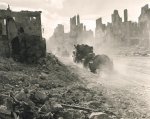
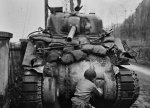
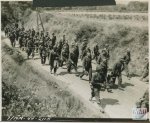
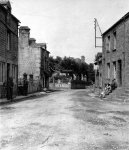
The Allies begin preparing a new offensive, codenamed Operation Paddle, in order to break the German lines to the east of Caen. The launch of this offensive is planned for August 17 and is to be led by the Belgian brigade of Colonel Piron. The first soldier of the Belgian Piron Brigade is killed in Normandy on August 16 - private Edouard Gerard, 20, killed at Sallenelles.
Hitler reverses his earlier decision and orders his troops out of Nor.mandy to a new defense line in north.eastern France on the Somme and Marne rivers. The Operation Dragoon landings in southern France opened a second front, providing the Allies with additional and sorely needed port facilities at Mar.seille and Tou.lon. In southern France, the French 2nd Corps (de Lattre), part of US 7th Army, comes ashore and moves forward.
George Patton is promoted to the permanent rank of major general, bypassing the permanent rank of brigadier general.
Over France, US 9th Air Force attacks transportation lines and a supply depot with 130 bombers. US 12th Air Force conducts 1,250 sorties in support of Allied ground troops in southern France. US 15th Air Force attacks transportation targets in southern France with 108 bombers.
Over Germany, US 8th Air Force attacks airfields, factories, and oil facilities with 976 bombers (23 lost), escorted by 612 fighters. US 15th Air Force attacks Friedrichshafen with 89 bombers. RAF Bomber Command sends 348 aircraft to attack Kiel and 23 aircraft to attack Berlin overnight.
On the eastern front, Soviet forces reach Ossow, only 7 miles northeast of Warsaw. However, a counterattack by German forces compels the Soviet troops to withdraw.
In Italy, US 5th Army and British 8th Army continue preparing for new offensive.
Pictured: Canadians move into Falaise; An American soldier checks out the gouge that a German armor-piercing projectile made on the front hull of this M4 Sherman medium tank. The cities of Orleans and Dreux fell to Patton’s Third Army on August 16, 1944; German prisoners, Le Muy, August 16, 1944; Beauvain, shortly after its liberation on august the 16th 1944. Three French civilians sit on some steps, closely observing the activities of two American soliders going about their business. The GI on the right is no ordinary soldier but Major General Manton Sprague Eddy, commander of the 9th US infantry division.




True, and it wasn't like they switched a lot of LSTs back and forth from the Pacific Theater of War to the European Theater of War. I think once they went to one theater of war or the other, they stayed there until the war was over.I think it was the limited LSTs, actually. IIRC there was a critical shortage of them throughout the war and they were used heavily in the Pacific theater's island-hopping.
The Allies divided the European Theater of War into two theaters of operations, the Mediterranean/North African Theater of Operations (MNATO) and the European Theater of Operations (ETO). Within the European Theater of War, LSTs could transfer from one theater of Ops to another. And using a scarce resource like and LST for something like over the beach logistics in Normandy means it cannot do something really special like conduct an amphibious landing in the south of France.
If the Allies had prioritized LSTs to Dragoon earlier, it would have put enormous pressure on the Germans to resource the defense of the south of France and kept some German units (like the 9th Panzer Division based near Bordeaux and probably others) from going to Normandy. I think the reason they kept using LSTs for "over the beach" logistics was it took the Allies so long to capture Cherbourg and the Cherboug port facilities were trashed when they took them.
I don't know. This is all Monday morning quarterbacking, but it is fun.
Last edited:
I think this is it. Look at the chimney in the background.August 16, 1944: ... Beauvain, shortly after its liberation on august the 16th 1944. Three French civilians sit on some steps, closely observing the activities of two American soliders going about their business. The GI on the right is no ordinary soldier but Major General Manton Sprague Eddy, commander of the 9th US infantry division.
View attachment 4153
https://www.google.com/maps/@48.6068986,-0.3080721,3a,75y,295.31h,92.35t/data=!3m6!1e1!3m4!1svVt5_ABOcTvKsGwaONFd7A!2e0!7i13312!8i6656
The French trio look like they are thinking, "Nothing ever happens in this village..."
Last edited:
Definitely the same. Two sets of stairs on the right. Brick fence posts between the buildings on the left and in front of the chimneyed house in the distance. Even the down spouts for the gutters are the same. The overhead electrical service has been removed.I think this is it. Look at the chimney in the background.
https://www.google.com/maps/@48.606...4!1svVt5_ABOcTvKsGwaONFd7A!2e0!7i13312!8i6656
The French trio look like they are thinking, "Nothing ever happens in this village..."
I love looking at these Then and now pictures.
Agree. Once having neutralized Italy, there was little point in continuing the march up the peninsula, other than to placate Churchill. He argued that we tied down German troops. However, minimal troops and feints would have accomplished the same...I think the reasons the Allies went with Italy before Marseilles were two:
1. It was the obvious choice in the summer of 1943, since they had captured all of North Africa and Sicily was within range for land-based aircraft, making an amphibious invasion possible.
2. Going after Italy could get the Italian government to collapse, getting the Italians out of the war.
Once the Italian government had collapsed, there was little point in continuing to attack in terrain so advantageous for the defenders.
Agreed. Plus, the further south the Allies staid, the more Italian coastline the Germans had to defend.Agree. Once having neutralized Italy, there was little point in continuing the march up the peninsula, other than to placate Churchill. He argued that we tied down German troops. However, minimal troops and feints would have accomplished the same...
August 17, 1944: The front line to the east of Caen, which has remained relatively stable since July 18, finally moves with the start of Operation Paddle, which aims at breaking up the German line of defense east of the Orne river. The 41st Royal Marines Commandos liberate the village of Troarn, resuming progress after a month of near stand-still. The Belgian Colonel Jean Piron pushes eastward and liberates Sallenelles, near the Orne river and continues his advance up to Franceville, which is attacked and liberated by 8:00 pm by the 3rd Motorized unit.
The 7th German Army and the 5th Panzer Army, almost completely surrounded, try to retreat beyond the Seine river. To do so, they must leave the pocket - which is slowly closing in on them. Many units gather in retreat to a 5 mile wide corridor remaining in the region of Chambois, the taking of which is the objective of the Polish 1st Armored Division and the Canadian 4th Armored Division. The French 2nd Armored Division also participates in the encirclement and pushes north of Ecouché in the face of the German 116th Armored Division. On August 17, the pocket is 10 miles wide and 20 miles long. The Germans are bombarded continuously, day and night. Allied airmen and gunners relentlessly attack the Wehrmacht and Panzer divisions as they attempt to retreat eastward toward the Seine river. Despite the disastrous situation for the German forces, their retreat is rapid: nearly a third of the Axis encircled forces slip out of the pocket today alone.
To the south and west, other American forces capture Dreux, Chateaudun and Orleans. In Brittany, the German defenders of the citadel at St. Malo surrender.
In southern France, there is little German resistance to the Allied advance of US 7th Army. St. Raphael, St. Tropez, Frejus, Le Luq and St. Maxime are captured during the day.
Over France, RAF Bomber Command sends 79 aircraft to attack Brest during the day. RAF 2nd Tactical Air Force conducting ground support missions, offensive sorties, and defensive patrols, including heavy attacks against the Falaise pocket. US 8th Air Force fighters attack transportation lines. Operation Aphrodite continues - an unmanned US 8th Air Force B-17 is successfully guided to attack target at La Pallice.
On the eastern front, in Lithuania, forces German Army Group North launches counterattacks along the entire line. Effort is concentrated on Siauliai with the objective of preventing Soviet forces from cutting off German-held Riga in Latvia. 33rd Army of Soviet 3rd Byelorussian Front pushes into East Prussia and crosses Sesupe River.
In Poland, the German commander in Warsaw sends envoy to the Home Army, threatening that if the Polish forces do not surrender, the city and all its inhabitants will be destroyed
In Italy, US 5th Army and British 8th Army continue preparing for new offensive.
Pictured: The formation of the Falaise Pocket from August 8–17 1944; A low level picture taken of destroyed German equipment that littered the Falaise Pocket area, much of it destroyed by Allied airpower that roamed at will over the roads packed with the transport of the 7th Army as it tried to escape the pocket; Canadian soldiers at the Falaise, France town entrance, August 17, 1944; A Sherman tank drives through the remains of Flers, August 17, 1944
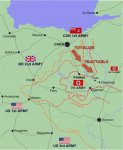
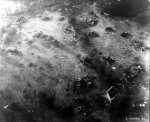
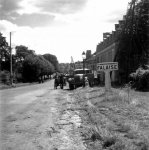
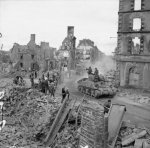
The 7th German Army and the 5th Panzer Army, almost completely surrounded, try to retreat beyond the Seine river. To do so, they must leave the pocket - which is slowly closing in on them. Many units gather in retreat to a 5 mile wide corridor remaining in the region of Chambois, the taking of which is the objective of the Polish 1st Armored Division and the Canadian 4th Armored Division. The French 2nd Armored Division also participates in the encirclement and pushes north of Ecouché in the face of the German 116th Armored Division. On August 17, the pocket is 10 miles wide and 20 miles long. The Germans are bombarded continuously, day and night. Allied airmen and gunners relentlessly attack the Wehrmacht and Panzer divisions as they attempt to retreat eastward toward the Seine river. Despite the disastrous situation for the German forces, their retreat is rapid: nearly a third of the Axis encircled forces slip out of the pocket today alone.
To the south and west, other American forces capture Dreux, Chateaudun and Orleans. In Brittany, the German defenders of the citadel at St. Malo surrender.
In southern France, there is little German resistance to the Allied advance of US 7th Army. St. Raphael, St. Tropez, Frejus, Le Luq and St. Maxime are captured during the day.
Over France, RAF Bomber Command sends 79 aircraft to attack Brest during the day. RAF 2nd Tactical Air Force conducting ground support missions, offensive sorties, and defensive patrols, including heavy attacks against the Falaise pocket. US 8th Air Force fighters attack transportation lines. Operation Aphrodite continues - an unmanned US 8th Air Force B-17 is successfully guided to attack target at La Pallice.
On the eastern front, in Lithuania, forces German Army Group North launches counterattacks along the entire line. Effort is concentrated on Siauliai with the objective of preventing Soviet forces from cutting off German-held Riga in Latvia. 33rd Army of Soviet 3rd Byelorussian Front pushes into East Prussia and crosses Sesupe River.
In Poland, the German commander in Warsaw sends envoy to the Home Army, threatening that if the Polish forces do not surrender, the city and all its inhabitants will be destroyed
In Italy, US 5th Army and British 8th Army continue preparing for new offensive.
Pictured: The formation of the Falaise Pocket from August 8–17 1944; A low level picture taken of destroyed German equipment that littered the Falaise Pocket area, much of it destroyed by Allied airpower that roamed at will over the roads packed with the transport of the 7th Army as it tried to escape the pocket; Canadian soldiers at the Falaise, France town entrance, August 17, 1944; A Sherman tank drives through the remains of Flers, August 17, 1944




For those unaware, more information about Operation Aphrodite, which used B-17 Flying Fortresses that had been taken out of service as 'precision guided munitions'.
Franceville, France? See, now that's just lazy.August 17, 1944: The Belgian Colonel Jean Piron pushes eastward and liberates Sallenelles, near the Orne river and continues his advance up to Franceville, which is attacked and liberated by 8:00 pm by the 3rd Motorized unit.
At least, no doubt about its origin. In Savoie, where my daughter lives, the original language was Aripitan, a cousin of Occitan, still spoken in parts of the southern France, northern Italian region, and also closely kin to Catalan. As a result, a lot of the place names in Savoie are definitely of non-French origin...Franceville, France? See, now that's just lazy.
Is Aripitan intelligible for French-speakers? I've never heard it, (although I have been to Haute Savoie.At least, no doubt about its origin. In Savoie, where my daughter lives, the original language was Aripitan, a cousin of Occitan, still spoken in parts of the southern France, northern Italian region, and also closely kin to Catalan. As a result, a lot of the place names in Savoie are definitely of non-French origin...
No, it's not. It's almost an extinct language at this point, normally found only in place names and artifacts in the local dialect. The locals speak a Provencal-Savoy dialect now. Occitan-Romance, the group which Arpitan belongs, is still alive, but hardly healthy. It does, however, still have several hundred thousand speakers, counting Catalan. IRRC, the terminilogy "Lingua (or langue D'Oc) actually comes from the vulgate Latin for "here," - "hoc." I've bought a pinot grigio for years, the "Cavit" brand, from northern Italy. The labels used to proudly state "Langue D'Oc." Now, they say, in Italian, "Delle Veniezie." Still same company, from Trento, (or Trent, if you prefer)...Is Aripitan intelligible for French-speakers? I've never heard it, (although I have been to Haute Savoie.
This is really off-topic (apologies Brad), but I found a page written by a native Occitan speaker, with an associated video.No, it's not. It's almost an extinct language at this point, normally found only in place names and artifacts in the local dialect. The locals speak a Provencal-Savoy dialect now. Occitan-Romance, the group which Arpitan belongs, is still alive, but hardly healthy. It does, however, still have several hundred thousand speakers, counting Catalan. IRRC, the terminilogy "Lingua (or langue D'Oc) actually comes from the vulgate Latin for "here," - "hoc." I've bought a pinot grigio for years, the "Cavit" brand, from northern Italy. The labels used to proudly state "Langue D'Oc." Now, they say, in Italian, "Delle Veniezie." Still same company, from Trento, (or Trent, if you prefer)...
That's what it sounds like to me. A lot of it is unintelligible, but there are also many words I can pick out and understand.
Written Langue d'Oc compares to French like this:
"Totas las personas naisson liuras e egalas en dignitat e en drech. Son dotadas de rason e de consciéncia e lor cal agir entre elas amb un esperit de frairesa". - Occitan (Langued'oc)
"Tous les êtres humains naissent libres et égaux en dignité et en droits. Ils sont doués de raison et de conscience et doivent agir les uns envers les autres dans un esprit de fraternité" - French
[Universal Declaration of Human Rights, article 1]
Spanish speakers will see some similarities to Langue d'Oc.
Last edited:
The fighting was not in the vicinity of Flers for very long, so I would not have anticipated just how beat-up Flers was by 17 Aug 44. Man, I guess it does not pay to throw a war in your own neighborhood.August 17, 1944: A Sherman tank drives through the remains of Flers, August 17, 1944
View attachment 4161
The reconstruction of Europe is still just so amazing...The fighting was not in the vicinity of Flers for very long, so I would not have anticipated just how beat-up Flers was by 17 Aug 44. Man, I guess it does not pay to throw a war in your own neighborhood.
It actually seems a bit more closely related to Spanish, but it's really older than both...This is really off-topic (apologies Brad), but I found a page written by a native Occitan speaker, with an associated video.
He says to a French speaker, Occitan sounds like a Frenchman speaking Catalan with a French accent.
That's what it sounds like to me. A lot of it is unintelligible, but there are also many words I can pick out and understand.
Written Langue d'Oc compares to French like this:
"Totas las personas naisson liuras e egalas en dignitat e en drech. Son dotadas de rason e de consciéncia e lor cal agir entre elas amb un esperit de frairesa". - Occitan (Langued'oc)
"Tous les êtres humains naissent libres et égaux en dignité et en droits. Ils sont doués de raison et de conscience et doivent agir les uns envers les autres dans un esprit de fraternité" - French
[Universal Declaration of Human Rights, article 1]
Spanish speakers will see some similarities to Langue d'Oc.
On 75th anniversary of WWII 'Operation Dragoon,' paratrooper recalls dropping into French Riviera
Forgive me that this is Fox News, but the star of the piece is the para who jumped into the Riviera in Op DRAGOON.
Forgive me that this is Fox News, but the star of the piece is the para who jumped into the Riviera in Op DRAGOON.
- Status
- Not open for further replies.
Latest threads
-
Bama Game Thread: Bama Gymnastics - NCAA Championship Semi-finals (ESPN2 | 4/18 @ 8pm CT)
- Started by BamaNation
- Replies: 20
-
No. 1 Visits Tuscaloosa for Second Straight Week as Alabama Hosts Top-Ranked Texas A&M
- Started by Diamond Tide
- Replies: 0
-
-
I'm Declaring the Emperor has no clothes (NCAA rules implosion)
- Started by BamaNation
- Replies: 27
-
Home-and-Home Series Wraps Up as Alabama Welcomes UAB on Tuesday
- Started by Diamond Tide
- Replies: 1
-

